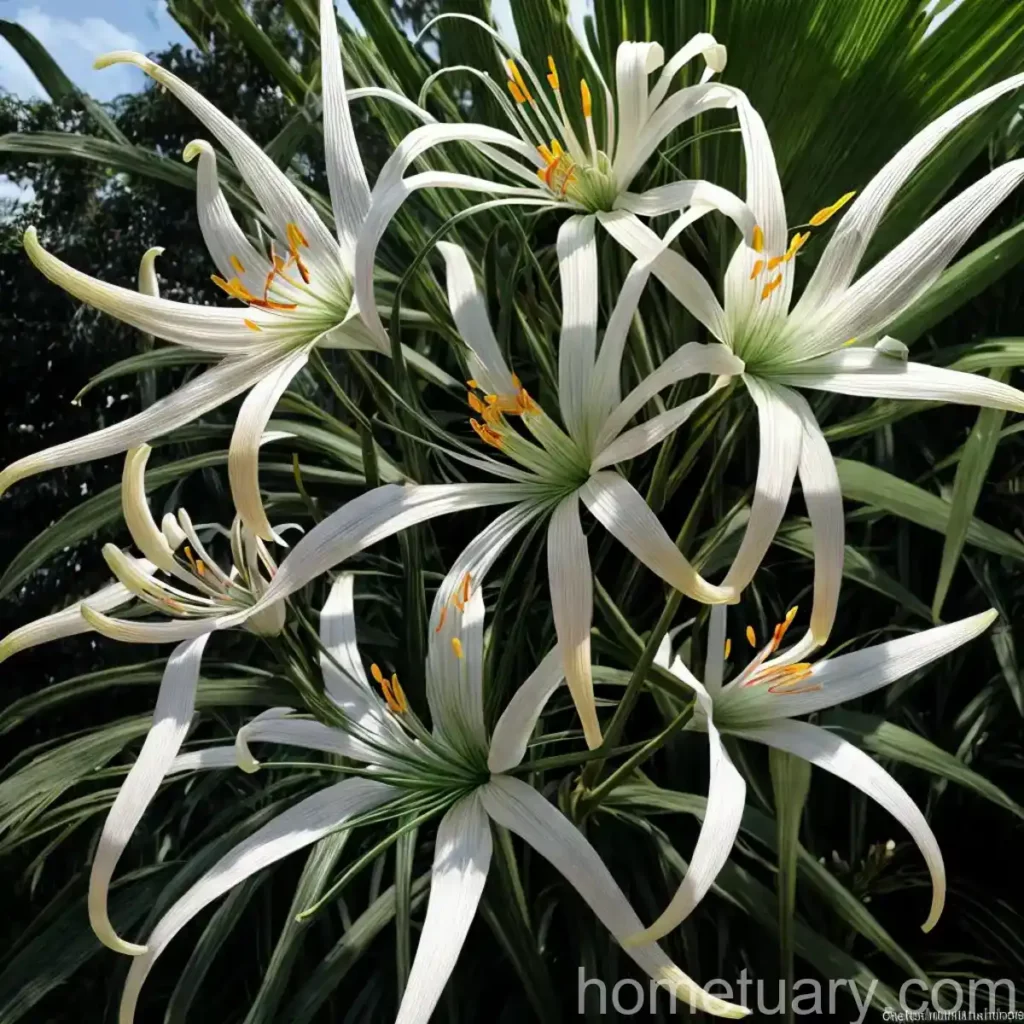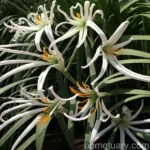Spider Lily (Hymenocallis liriosme): A Comprehensive Plant Care Guide
Introduction
Plants are not only essential for the environment but also add beauty and tranquility to any space. Spider lilies, scientifically known as Hymenocallis liriosme, are unique and fascinating plants that can capture the attention of any plant lover. In this comprehensive guide, we will explore the intricacies of spider lilies, from their growth patterns and characteristics to their cultural significance and uses. Whether you’re a novice gardener or an experienced horticulturist, this guide will provide you with valuable insights into the care and maintenance of spider lilies.
Plant Name
- Common Name: Spider Lily
- Scientific Name: Hymenocallis liriosme
What is Spider Lily (Hymenocallis liriosme)?
Spider lilies belong to the genus Hymenocallis, which is a part of the Amaryllidaceae family. These plants are native to the Americas and are known for their striking appearance, featuring unique spider-like flowers that are sure to captivate any observer. Spider lilies are perennial bulbous plants that are primarily cultivated for their ornamental value, making them a popular choice for gardens and landscapes.
Key Takeaways – Spider Lily (Hymenocallis liriosme)
Before delving into the specific aspects of spider lily care, it’s important to understand the key takeaways associated with these plants:
- Spider lilies are perennial bulbous plants known for their distinctive spider-like flowers.
- They are part of the Hymenocallis genus within the Amaryllidaceae family.
- Spider lilies are popular ornamental plants used in gardens and landscapes.
- Understanding their cultural requirements and uses is essential for successful cultivation and maintenance.
With these key takeaways in mind, let’s explore the essential aspects of caring for spider lilies, including their cultural requirements, uses, maintenance practices, and more.
Cultural Requirements of Spider Lilies
Water
Appropriate watering is crucial for the healthy growth of spider lilies. These plants require consistently moist but not waterlogged soil. During the active growing season, regular watering is necessary to ensure adequate moisture for the bulbs and roots. However, it’s important to avoid overwatering, as this can lead to root rot and other moisture-related issues. During the dormant season, reduce watering but ensure that the bulbs do not completely dry out.
Sunlight
Spider lilies thrive in partial to full sunlight. They prefer bright, indirect light and can also tolerate direct sunlight, especially during the growing season. When grown outdoors in garden beds, ensure that they receive adequate sunlight, but protect them from intense afternoon sun, particularly in hot climates. For indoor cultivation, place spider lilies near windows that provide bright, filtered light.
Soil
Well-draining, nutrient-rich soil is ideal for spider lilies. A loamy or sandy soil with good drainage properties is recommended to prevent waterlogging and root rot. Additionally, a slightly acidic to neutral pH range is suitable for these plants. When planting spider lilies, incorporate organic matter such as compost or well-rotted manure into the soil to improve its fertility and structure.
Fertilizer
Fertilizing spider lilies can bolster their growth and flowering capacity. Use a balanced, slow-release fertilizer specifically formulated for flowering plants. Applying fertilizer in early spring as new growth emerges can provide the necessary nutrients for robust development. It’s essential to follow the manufacturer’s instructions regarding the application rate and frequency to avoid over-fertilization, which can harm the plants.
Pruning
Regular pruning is not necessary for spider lilies. However, removing spent flowers and withered foliage can enhance the plant’s appearance and prevent the formation of seed pods, redirecting its energy towards bulb development and future growth. Use clean, sharp gardening shears to trim faded flowers and yellowing leaves as needed.
Propagation
Spider lilies can be propagated through division or seed sowing. Division involves separating the bulbs and replanting them to establish new plants. This method is commonly preferred due to its reliability and faster results. Alternatively, spider lilies produce seeds that can be collected and sown to grow new plants. However, seed propagation requires more time and patience to observe the plants’ growth and development.
Container Cultivation
Spider lilies can thrive in containers, making them suitable for indoor and patio gardening. When growing spider lilies in containers, ensure that the pots have drainage holes to prevent waterlogging. Use a well-draining potting mix designed for bulbous plants and provide adequate space for the bulbs to grow and expand. Container-grown spider lilies may require more frequent watering and fertilization compared to those grown in garden beds due to the limited soil volume.
Popularity
Spider lilies are admired for their striking appearance and are popular ornamental plants in gardens, parks, and landscaping projects. Their unique flowers and adaptability make them a sought-after choice for adding visual interest and elegance to various outdoor spaces.
Common Diseases and Pests
Despite their overall resilience, spider lilies are susceptible to certain diseases and pests that can affect their health and vitality. Understanding these potential issues and implementing preventive measures is essential for maintaining robust, disease-free plants.
Common Diseases
- Leaf Spot: Fungal infections can lead to the development of circular brown spots on the leaves. To prevent leaf spot, practice proper watering techniques and ensure good air circulation around the plants.
- Root Rot: Overwatering and waterlogged soil can cause root rot, leading to wilting and yellowing of the foliage. Use well-draining soil and avoid excessive watering to mitigate the risk of root rot.
- Botrytis Blight: This fungal disease can cause flower blight and decay. Maintain adequate spacing between plants to promote air circulation and reduce humidity, which can create an environment conducive to Botrytis development.
Disease Diagnosis
Diagnosing plant diseases requires careful observation of the symptoms and overall plant health. If you notice unusual spots, wilting, or discoloration on your spider lilies, it’s important to inspect the plants closely and identify the potential causes. Seek guidance from experienced gardeners or plant health professionals to accurately diagnose and treat any diseases affecting your spider lilies.
Common Pests
- Aphids: These small, soft-bodied insects can cluster on the undersides of leaves and feed on plant sap, leading to stunted growth and distorted foliage. Use insecticidal soap or neem oil to control aphid infestations.
- Spider Mites: These tiny arachnids can cause webbing on the plants and result in yellowing and speckling of the foliage. Regularly misting the plants and maintaining adequate humidity levels can help prevent spider mite infestations.
Botanist’s Tips
To promote the health and vigor of spider lilies, consider the following tips from experienced botanists and horticulturists:
- Monitor Moisture Levels: Regularly check the soil moisture to ensure it remains consistently moist but not waterlogged, especially during the active growing season.
- Support Healthy Growth: Provide adequate support for the plants, such as staking taller varieties to prevent bending or breakage of flower stalks.
- Manage Pests Proactively: Inspect your spider lilies regularly for signs of pest infestations and take prompt measures to control and manage any issues that arise.
Fun Facts
- Spider lilies are sometimes referred to as “swamp lilies” due to their affinity for moist habitats.
- Certain species of spider lilies have been used in traditional medicine for their purported medicinal properties.
Links to External Resources
For further information on spider lilies and related topics, explore the following resources:
- The American Horticultural Society A-Z Encyclopedia of Garden Plants
- Royal Horticultural Society: Spider Lily Cultivation Guide
In conclusion, spider lilies are captivating plants that offer unique beauty and a touch of elegance to diverse settings. By understanding and implementing the recommended care and maintenance practices, you can cultivate thriving spider lilies and enjoy their stunning blooms throughout their growing seasons. Whether you’re a gardening enthusiast, a landscape designer, or simply a lover of nature, spider lilies are sure to leave a lasting impression with their remarkable charm and allure.
Keywords: Spider lily growing tips, How to care for spider lilies, Spider lily plant care guide, Spider lily care and maintenance, Spider lily plant characteristics, Spider lily varieties, Spider lily planting guide, Best conditions for spider lilies, Spider lily watering requirements, Spider lily sunlight needs, Spider lily soil preferences, Spider lily propagation methods, Spider lily pest control, Spider lily diseases and treatments, Spider lily blooming season, Spider lily flower anatomy, Spider lily medicinal uses, Spider lily in landscaping, Spider lily companion plants, Spider lily symbolic meanings, Spider lily folklore and legends, Spider lily as cut flowers, Spider lily indoor cultivation, Spider lily outdoor cultivation, Spider lily container gardening, Spider lily as a houseplant, Spider lily for beginners, Spider lily wildlife attraction, Spider lilies for pollinators, Spider lily for butterfly gardens, Spider lily in tropical gardens, Spider lily in coastal gardens, Spider lily garden design ideas, Spider lily for shade gardens, Spider lily for sunny locations, Spider lily seasonal changes, Spider lily hardiness zones, Spider lily native habitats, Spider lily landscape maintenance, Spider lily naturalized areas, Spider lily for erosion control, Spider lily for wetland restoration, Spider lily in rock gardens, Spider lily in water gardens, Spider lily as a centerpiece plant, Spider lily for exotic gardens, Spider lily container arrangements, Spider lily for borders and edges, Spider lily in mixed flower beds, Spider lily color variations















